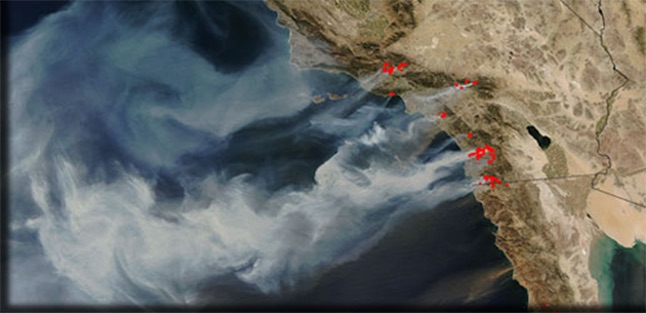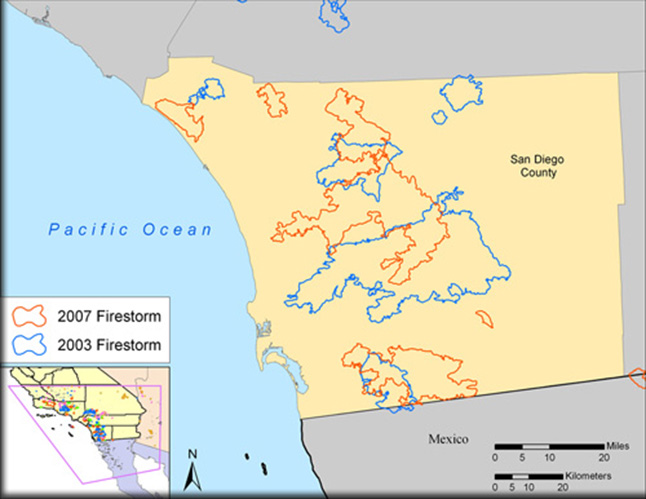Dr. Nancy French of MTRI headed a study funded by the National Institute of Environmental Health Sciences, a part of the National Institutes of Health (NIH), to measure and statistically model a relationship between particulate emissions from wildland fires and respiratory illness and then assess the impact of future climatic conditions as manifest in respiratory health outcomes. The study is affiliated with the NIH Climate Change and Health Initiative and funded through the American Recovery and Reinvestment Act (ARRA).
Project Overview
Southern California faces a unique set of challenges heading into the 21st century. Its high urban population density is concentrated along the coast, but is highly proximate to rural areas dominated by fire-driven ecosystems, an area known as the Wildland-Urban Interface (WUI; Radeloff et al. 2005). This large WUI area coupled with a climate phenomena known as the Santa Ana winds make Southern California susceptible to large wildfire disasters (Schroeder et al. 1964, Westerling et al. 2004, Keeley et al. 2004). The Santa Ana Winds create an ideal fire weather environment by exacerbating already dry conditions and moving hot air at high speeds through dry shrublands, causing fires ignited in rural areas to be pushed into urban regions of the state. This was exemplified in 2003 and 2007, when large wildfires swept over San Diego County, burning approximately 650,000 acres of grassland and chaparral, killing and injuring several people, and incurring over $3.8 billion in property damages (Karter 2004, Karter 2008). Models of future climate predict weather conditions that will increase the occurrence and severity of wildland fires (Westerling et al. 2006), so it is important to understand how future climate will alter fire regimes and impact public health.


Connecting Wildland Fire PM to Respiratory Health
There are three specific components to the integrated modeling activity: 1) modeling spatially-defined fire emissions, taking into account vegetation fuels and weather, 2) accurately estimating particulate concentrations for downwind regions using transport/dispersion modeling, and 3) combining the smoke emissions with electronic health monitoring to relate the modeled spatial/temporal distribution of pollution to the rates and spatial location of respiratory symptoms. We carried out the development of the predictive model via a Generalized Additive Modeling (GAM) approach, able to incorporate emissions-transport, demographics, weather, and scheduling (day of week) information to derive an accurate predictive relationship for describing the impacts of fire on respiratory health in San Diego County.
Final model results ( ~75% deviance explained) show that at peak fire particulate concentrations the odds of a person seeking emergency care is increased by approximately 50 percent compared to non-fire conditions.

Climate Change Effects on Future Fire Occurrence and Health Outcomes
Analysis of future fire occurrence shows San Diego County will experience approximately two extreme fire seasons each decade through 2040. We are in the process of finalizing a manuscript to demonstrate the application of the model connecting wildland fire smoke concentration to health outcomes in years of these extreme fire conditions. Our initial results show that the model formulation can be used to assess the location and impact of elevated PM concentrations from particulate emissions originating from wildfire in and around San Diego county that could be valuable for use by public health officials. In a proposed additional grant activity, we hope to work more closely with public health agencies and first responders to better define the value of applying our model and how products we could generate from this study can be improved for their use.
Highlights of Project Outcomes and Results
Our interdisciplinary research team developed a coupled statistical and process-based model system that:
- Demonstrates an end-to-end methodology for generating reasonable estimates of wildland fire particulate matter concentrations and effects on respiratory health
- Is applicable at resolutions compatible with syndromic surveillance health information
- Has applicability to other regions and syndromic responses although model coefficients and functional estimates are specific to San Diego County
- Shows through model results that at peak fire particulate concentrations the odds of a person seeking emergency care is increased by approximately 50 percent compared to non-fire conditions.
- Shows through future fire occurrence modeling that San Diego County will experience approximately two extreme fire seasons each decade by 2040, similar to the present.
- Demonstrated the impact of wildfire under climate change on emergency department visits
- Showed the value of syndromic surveillance data, which are rapidly being developed across the US, for post-disaster analytic work
- Helped, via the grant, to expand the San Diego syndromic surveillance capacity by adding several new hospitals to the SDADIC syndromic surveillance network.
- Promoted, through the project activity, collaboration between public health and environmental modeling communities to better understand determinants of health during a disaster.

Project Outputs
Peer-Review Journal Submissions
- Hutchinson, Justine A., Jason Vargo, Meredith Milet, Nancy H. F. French, Michael Billmire, Jeffrey Johnson, and Sumi Hoshiko. 2018. "The San Diego 2007 wildfires and Medi-Cal emergency department presentations, inpatient hospitalizations, and outpatient visits: An observational study of smoke exposure periods and a bidirectional case-crossover analysis." PLOS Medicine 15 (7):e1002601. doi: 10.1371/journal.pmed.1002601.
- Thelen, B., N. French, B. Koziol, M. Billmire, R. Owen, J. Johnson, M. Ginsberg, T. Loboda, and S. Wu (2013), Modeling acute respiratory illness during the 2007 San Diego wildland fires using a coupled emissions-transport system and generalized additive modeling, Environmental Health, 12(1), 94.
- Billmire, M., N.H.F. French, T. Loboda, R.C. Owen, and M. Tyner. “Santa Ana winds and predictors of wildfire progression in southern California.” Submitted to International Journal of Wildland Fire.
- Huang, Y., S. Wu, M. K. Dubey, and N. H. F. French (2013), Impact of aging mechanism on model simulated carbonaceous aerosols, Atmospheric Chemistry and Physics, 13(13), 6329-6343, doi:10.5194/acp-13-6329-2013.
- Loboda, T., et al. “Modeling Fire Occurrence as a function of Landscape Characteristics: A case study from San Diego county, California” In preparation for submission to Journal of Disaster Risk Reduction.
- French, N.H.F., et al. “Wildfire Particulate Emissions and Respiratory Health: Model application and implications under a changing climate”.
- In preparation for submission to Environmental Health Perspectives.
Presentations
- NIH Grant#: 1 RC1 ES018612
Project Performance Period: Oct 2009 through July 2012 - April 2012: IAWF Human Dimensions of Wildland Fire Seattle, WA N French poster presentation “Respiratory Health Impacts of Wildfire Particulate Emissions under Climate Change Scenarios”
- June 2012: ACCENT-IGAC-GEIA (Global Emissions InitiAtive) Conference Toulouse, France Poster presentation by N. French “Respiratory Health Impacts of Wildfire Particulate Emissions under Climate Change Scenarios”
- June 2012: ENVIROMIS 2012 Irutsk, Russia Invited report by T Loboda “The role of satellite observations in assessing impacts of wildfire occurrence on respiratory health of population”
- June 2012: NASA Science Meeting, GOFC-GOLD and NEESPI Workshop and Regional Conference Volga, Russia Invited talk by T Loboda “The role of satellite observations in assessing impacts of wildfire occurrence on respiratory health of population”
- June 2012: NEHA San Diego, CA Oral presentation by N. French, R.C. Owen, M. Ginsberg, J. Johnson, M. Billmire. “Wildfire Particulate Emissions and Respiratory Health under Climate Change Scenarios: Project overview and results”
- December 2011: AGU Fall’11 San Francisco, CA:
- Oral presentation by M Billmire. “Santa Ana winds and predictors of wildfire progression in southern California”
- Poster presentation by T Loboda. “Modeling fire occurrence as a function of landscape”
- Poster presentation by Y Huang. “Effects of updated aging scheme on the model simulation of global carbonaceous aerosols”
- June 2011: National Environmental Health Association (NEHA) Columbus, OH, Poster presentation by N. French and B. Koziol. “Respiratory Health Impacts of Wildfire Particulate Emissions under Climate Change Scenarios”
- April 2011: American Association of Geographers Seattle, WA Oral presentation by T. Loboda. “Evaluating impacts of climate-driven change in fire regimes on human and natural systems using a Fire Occurrence Model”
- December 2010: American Geophysical Union (AGU) Fall’10 San Francisco, CA Poster presentation by B Koziol. “Modeling PM Plumes from 2007 California Wildland Fires using a Coupled Emissions-Transport System”
